March 2018 LIP of the Month
How Large Igneous Provinces affect global climate, sometimes cause mass extinctions, and represent natural markers in the geological record
Richard E. Ernst (1,2), Nasrrddine Youbi (3,4)
1 Department of Earth Sciences, Carleton University, Ottawa, ON K1S 5B6, Canada
2 Faculty of Geology and Geography, Tomsk State University, 36 Lenin Ave, Tomsk 634050, Russia
3 Department of Geology, Faculty of Sciences-Semlalia, Cadi Ayyad University, Marrakesh, Morocco
4 Instituto Dom Luiz, Faculdade de Ciências, Universidade de Lisboa, 1749-016, Lisboa, Portugal
Extracted and modified from:
Ernst, R.E., Youbi, Y. (2017). How Large Igneous Provinces affect global climate, sometimes cause mass extinctions, and represent natural markers in the geological record. Palaeogeography, Palaeoclimatology, Palaeoecology, v. 478, p. 30-52
Large Igneous Provinces (LIPS)
Large Igneous Provinces (LIPs) represent large volume (>0.1 Mkm3; frequently above 1 Mkm3), mainly mafic (-ultramafic) magmatic events of intraplate affinity, that occur in both continental and oceanic settings, and are typically of short duration (<5 Myr) or consist of multiple short pulses over a maximum of a few 10s of Myr (Coffin and Eldholm 1994, 2005; Bryan and Ernst 2008; Bryan and Ferrari 2013; Ernst 2014; Ernst and Youbi 2017; cf. alternative definition in Sheth 2007). See Figures 1 and 2 for global distribution and barcode diagram. They comprise volcanic packages (flood basalts), and a plumbing system of mafic dyke swarms, sill complexes, layered intrusions, and a lower crustal magmatic underplate. LIPs can also be associated with silicic magmatism (including dominantly silicic events termed Silicic LIPs, or SLIPs), carbonatites and kimberlites. LIPs occur at a variable rate that averages approximately every 20–30 Myr back to at least 2.5 Ga, but with possible peak frequencies associated with supercontinent breakup. The rate of LIP occurrence in the Archean is less certain due to its poorer preservation.
LIPs are systematically linked to continental breakup (or attempted breakup) events (e.g. Bleeker and Ernst 2006; Ernst 2014), ore deposits of a variety of commodity types (Ernst and Jowitt 2013, 2017), have an effect on hydrocarbon and aquifers (Ernst, 2014), have implication for planetary analogues (Ernst et al. 2016), and in the context of this LIP of the Month, have influence on global climate change including mass extinction events (Ernst 2014; Ernst and Youbi 2017).
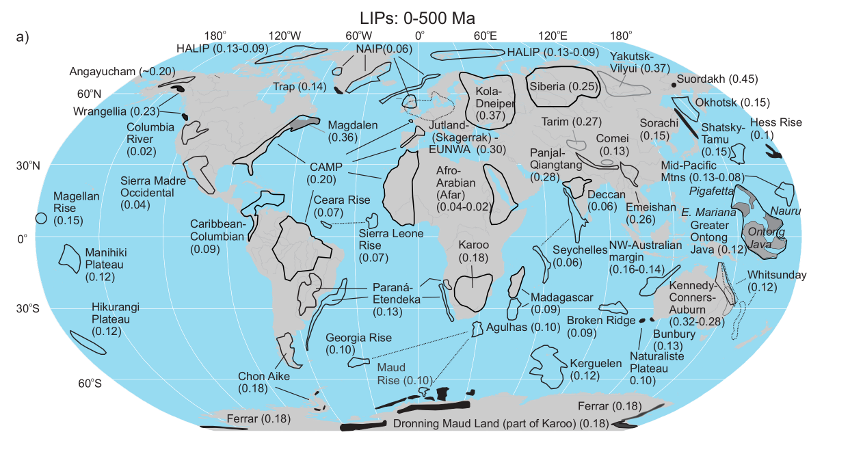
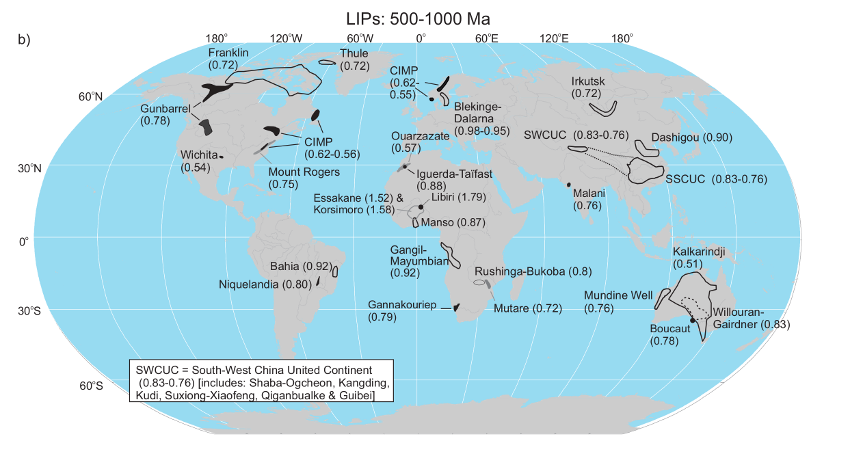
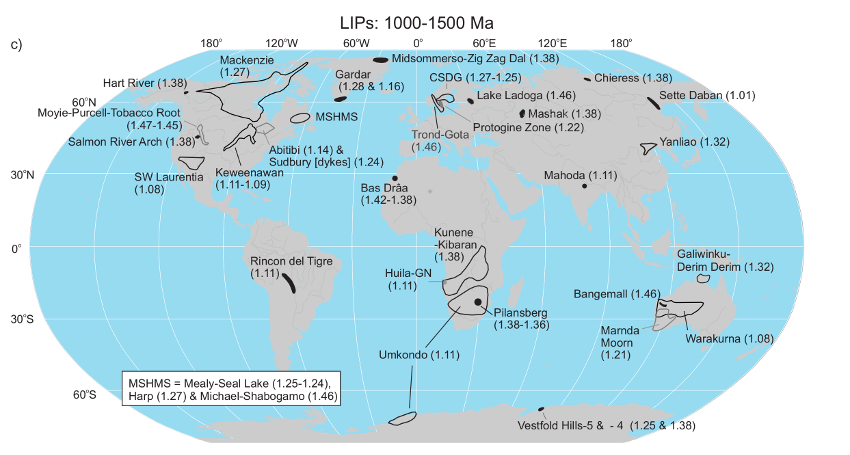
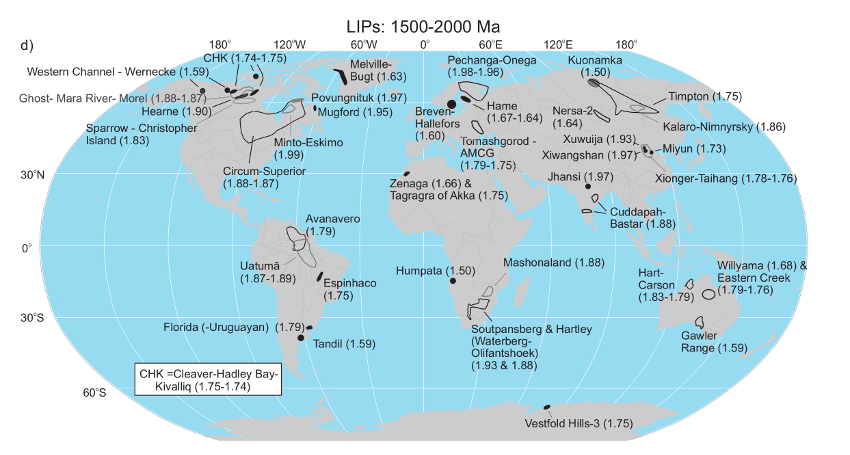
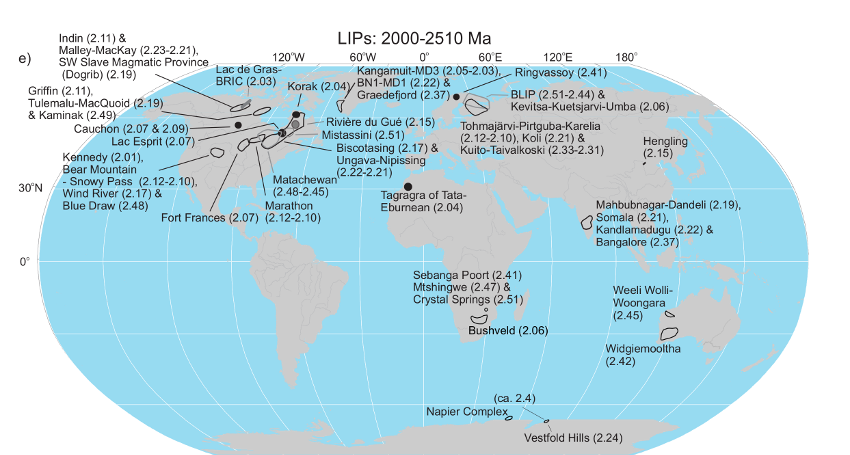

Figure 1: Parts a–f. Generalized distribution of LIPs and interpreted LIP fragments through time (updated from Ernst, 2014). Numbers are in Ga. Selected associated silicic LIPs (SLIPs) are shown (i.e. 0.32–0.28 Ga Kennedy-Connors-Auburn, 0.04 Ga Sierra Madre Occidental and 0.12 Ga Whitsunday. Maps are in Robinson Projection.

Figure 2: Global LIPs barcode record with selected labelling (updated from Ernst, 2014). Each LIP name is followed by location information: Am=Amazonia, AS=Asia, AU=Australia, CA=Central America, CC=Congo craton, EU=Europe, gLau=Greenland portion of Laurentia, Lau=Laurentia, Bal=eastern Baltica, SFC=Sao Francisco craton, Kal=Kalahari craton, Kap= Kaapvaal craton, KKC = Karelia-Kola craton, NA = North America, NAC=North Australian craton, NC= Nain craton, PA =Pacific, Pil = Pilbara craton, SA = South America, Sib =northern Siberian craton, Sla=Slave craton, Sup=Superior craton, WAC=West African craton, Wyo=Wyoming craton, Yil=Yilgarn craton, Zim=Zimbabwe craton. Names for Silicic LIPs are in red color, for continental LIPs are in black and for oceanic LIPs are in blue.
Summary of environmental effect of LIPS
Large Igneous Provinces (LIPs) are increasingly recognized to have a significant global environmental effect on the atmosphere and ocean as monitored in the sedimentary record (e.g. by compositional/isotopic data that reflect abrupt changes in temperature, pH, redox conditions, and in critical trace elements such as Hg, and also by abrupt changes in flora and fauna abundance) (e.g. Courtillot 1999; Wignall 2001, 2005; Bond and Wignall 2014; Kidder and Worsley 2010, 2012; Bond and Grasby 2017; Ernst and Youbi 2017; Goldschmidt 2018; see figures 3-6). Improved U-Pb dating (with better than 0.1 Myr resolution) for several LIPs is confirming the long-proposed mass extinction-LIP link (Fig. 3): such as for the 251 Ma Siberian Traps LIP (Burgess et al. 2014; Burgess and Bowring 2015); the 201 Ma CAMP LIP (Blackburn et al. 2013; Schoene et al. 2010); and the 66 Ma Deccan LIP (Schoene et al. 2015). The most dramatic climatic effect (and kill mechanism) is global warming due to greenhouse-gases from LIPs. Subsequent cooling (and even global glaciations) can be caused by CO2 drawdown through weathering of LIP-related basalts, and/or by sulphate aerosols. An impressive example is the now robust link between the onset of the Sturtian glaciation (ca. 717–660 Ma) and the 725–715 Ma Franklin LIP of northern Laurentia (Macdonald and Wordsworth, 2017) and with additional environmental effect due to the coeval Irkutsk LIP in formerly attached southern Siberia (Ernst et al. 2016). A link with the Gaskiers glaciation is also now proposed (Ernst and Youbi 2017; Youbi et al. 2018).
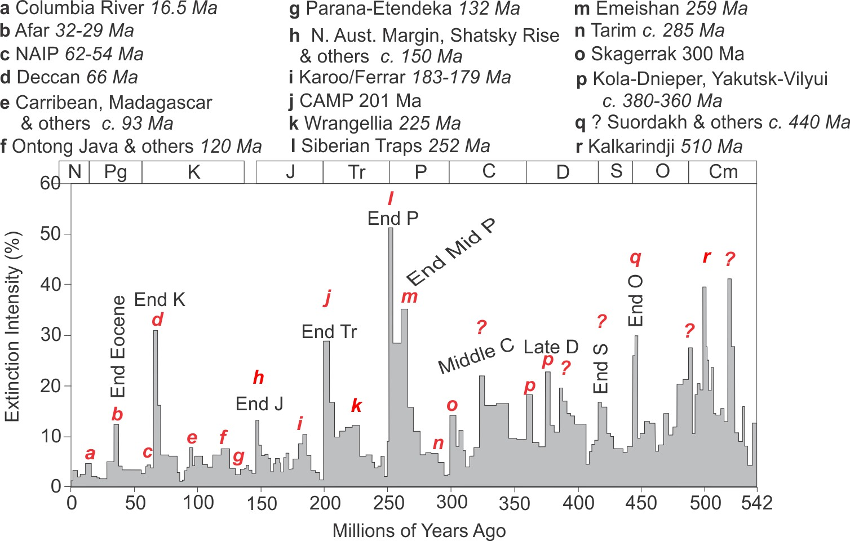
Figure 3: Correlation of LIP events with extinction events, updated from Ernst (2014). This figure shows the genus extinction intensity, i.e. the fraction of genera that are present in each interval of time but do not exist in the following interval. The data are from Rohde and Muller (2005), and are based on Sepkoski (2002). The curve is based on marine genera with the LIP record superimposed. (Modified from Fig. A2 in Supplementary files of Rohde and Muller (2005) to include links with the LIP record.)
Additional kill mechanisms that can be associated with LIPs include oceanic anoxia, ocean acidification, sea level changes, toxic metal input, essential nutrient decrease, producing a complex web of catastrophic environmental effects (Figs. 4-6). Notably, the size of a LIP is not the only important factor in contributing to environmental impact (e.g. Wignall 2001). Of particular significance are the rate of effusion, and the abundance of LIP-produced pyroclastic material and volatile fluxes that reach the stratosphere. While flood basalt degassing (CO2, SO2, halogens), and pyroclastic release are is important (and is also from associated silicic volcanism; e.g. Cather et al. 2009), a significant amount of these gases are released from volatile-rich sedimentary rocks (e.g. evaporites and coal horizons) heated by the intrusive component of LIPs (e.g. Svensen et al. 2009). Feedbacks are important, such as global warming leading to destabilization of clathrates, consequent release of further greenhouse gases, and greater global warming. In the broadest sense LIPs can affect (or even induce) shifts between Icehouse, Greenhouse and Hothouse climatic states (e.g. Kidder and Worsley, 2010, 2012). However, the specific effects, their severity, and their time sequencing is specific to each LIP.
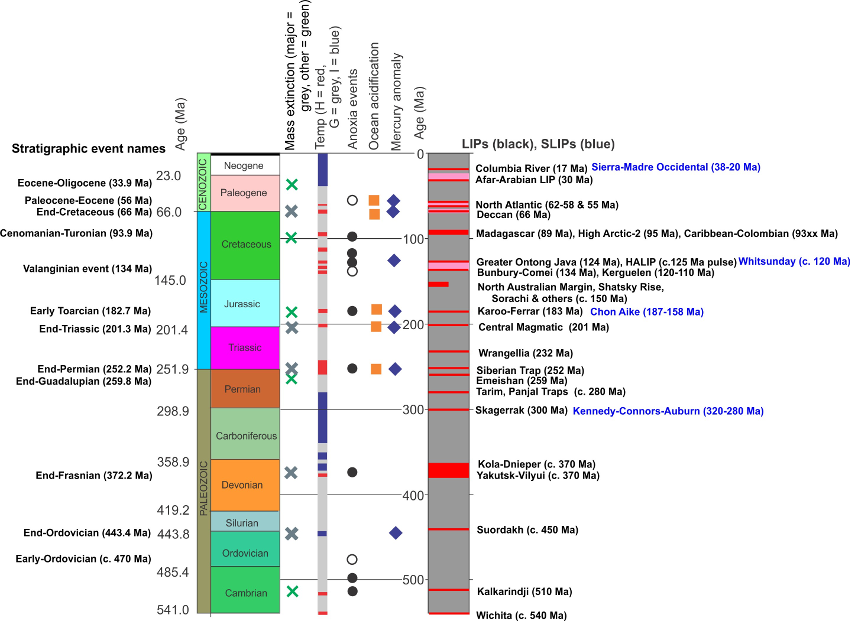
Figure 4: Phanerozoic record of mass extinctions, temperature conditions (Hothouse (H), Greenhouse (G), Icehouse (I)), oceanic anoxic events, mercury/TOC anomalies, in comparison with the Phanerozoic LIP record. Incorporates environmental data presentation style after Percival et al., 2015). Open circles are carbon-isotope excursion and/or black shale not recognized as a OAE. Information mainly from Supplementary Table 1 of Ernst and Youbi 2017. Global temperature shifts between Hothouse, Greenhouse and Icehouse mostly after Kidder and Worsley, 2010). LIPs are marked by red bars, and their lower volume continuations, by pink bars.
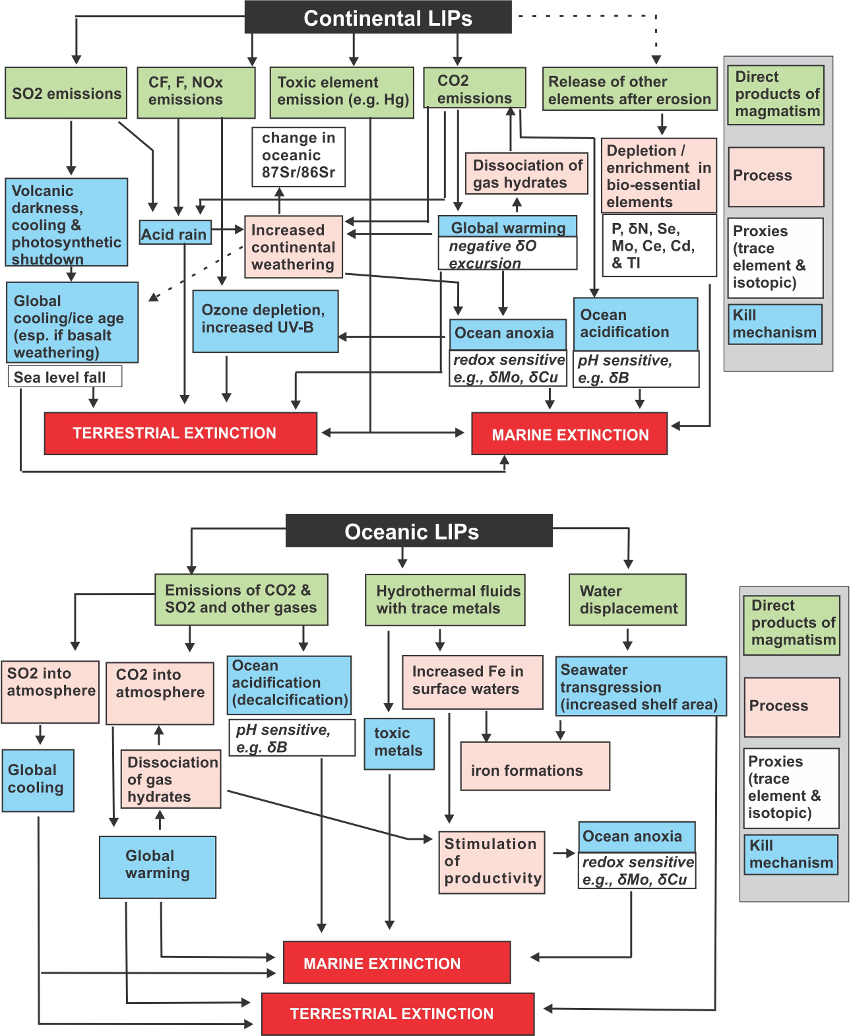
Figure 5: Flow chart showing environmental effects for both continental and oceanic LIP. Continental LIP modified after Bond and Wignall (2014). Oceanic LIPs modified after Kerr (2005, 2014).
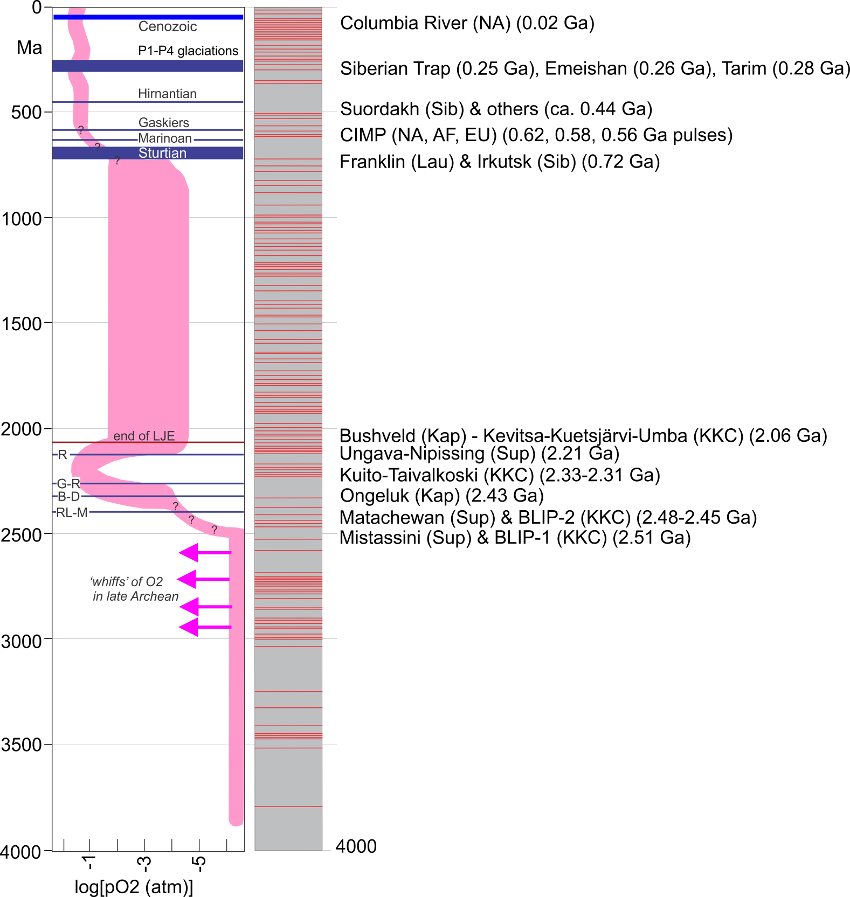
Figure 6: Link between LIPs and progressive oxygenation of the Earth. Oxygenation curve from Fig. 1 in Lyons et al. (2014). Distribution of Paleoproterozoic glacial intervals from Gumsley et al. (2017). Source of information on other glacial intervals from other references discussed in text. Global LIP barcode shown with specific events relevant to the glacial and oxygenation record labelled. End of LTE = end of Lomagundi-Jatuli Excursion. Paleoproterozoic glaciations (after Gumsley et al., 2017) are: R = Rietfontein, G-R = Gowganda-Rooihoogte, B-D = Bruce-Duitschland, RL-M = Ramsley Lake-Makganyene. Location labels (in parentheses) after LIP names explained in Fig. 2 caption.
Implications for the precambrian record and time boundaries
Based on the robust array of environmental effects due to LIPs, as demonstrated in the Phanerozoic record, it is suggested that LIP events represent useful time markers in the Precambrian Era as proxies for some significant global environmental changes that are preserved in the sedimentary record (Ernst and Youbi 2017). For instance, there is a potential correlation with black shale events notably at 1380 Ma (e.g. Zhang et al. 2018a,b), and with stepwise oxygenation (Fig. 6). Given their potential to cause severe global environmental impacts, LIPs can represent proxies for such “golden spike” boundaries. While the LIP event itself may be regional, its environmental effects are global. As a contribution toward the identification of appropriate natural boundaries, the current Proterozoic LIP record (Ernst, 2014) is canvassed for candidates to mark such boundaries. LIPs at 2500–2450, 2100, 2060, 1880, 1790–1750, 1525–1500, 1460, 1380, 1270, 1110, 825, 720, 615–560, 510 Ma are of particular significance for their scale and likely short duration of magmatic pulse(s) (Figs. 1,2; also see Table 1 in Ernst and Youbi 2017).
Click to open/close ReferencesReferences
Blackburn, T.J., Olsen, P.E., Bowring, S.A., McLean, N.M., Kent, D.V., Puffer, J., McHone, G., Rasbury, E.T., Et-Touhami, M., 2013. Zircon U–Pb geochronology links the end-Triassic extinction with the Central Atlantic Magmatic Province. Science 340, 941–945.
Bleeker, W., Ernst, R. (2006). Short-lived mantle generated magmatic events and their dyke swarms: the key unlocking Earth’s paleogeographic record back to 2.6 Ga. In: E. Hanski, S. Mertanen, T. Rämö. J. Vuollo (eds.) Dyke Swarms – Time Markers of Crustal Evolution. Taylor and Francis Group/ Balkema, London, pp. 3-26.
Bond, D.P.G., Grasby, S.E., 2017. On the causes of mass extinctions. Palaeogeogr. Palaeoclimatol. Palaeoecol. 478, 3–29.
Bond, D.P.G., Wignall, P.B., 2014. Large igneous provinces and mass extinctions: an update. In: Keller, G., Kerr, A.C. (Eds.), Volcanism, Impacts and Mass Extinctions: Causes and Effects. Geological Society of America Special Paper 505, pp. 29–55.
Bryan, S., Ernst, R.E., 2008. Revised definition of Large Igneous Provinces (LIPs). Earth Sci. Rev. 86, 175–202.
Bryan, S.E., Ferrari, L., 2013. Large Igneous Provinces and Silicic Large Igneous Provinces: progress in our understanding over the last 25 years. Geol. Soc. Am. Bull. 125, 1053–1078.
Burgess, S.D., Bowring, S.A., 2015. High-precision geochronology confirms voluminous magmatism before, during and after Earth's most severe extinction. Sci. Adv. 1 (7), e1500470. http://dx.doi.org/10.1126/sciadv.1500470.
Burgess, S.D., Bowring, S., Shen, S.-Z., 2014. High-precision timeline for Earth's most severe extinction. Proc. Natl. Acad. Sci. 111, 3316–3321 (correction 2014, 111: 5050).
Cather, S.M., Dunbar, N.W., McDowell, F.W., McIntosh, W.C., Scholle, P.A., 2009. Climate forcing by iron fertilization from repeated ignimbrite eruptions: the icehouse-silicic large igneous province (SLIP) hypothesis. Geosphere 5, 315–324.
Coffin, M.F., Eldholm, O., 1994. Large igneous provinces: crustal structure, dimensions, and external consequences. Rev. Geophys. 32, 1–36.
Coffin, M.F., Eldholm, O., 2005. Large igneous provinces. In: Selley, R.C., Cocks, R., Plimer, I.R. (Eds.), Encyclopedia of Geology. Elsevier, Oxford, pp. 315–323.
Courtillot, V., 1999. Evolutionary Catastrophes: the Science of Mass Extinctions. Cambridge University Press, Cambridge.
Ernst, R.E., 2014. Large Igneous Provinces. Cambridge University Press (653 p.).
Ernst, R.E., Jowitt, S.M., 2013. Large Igneous Provinces (LIPs) and metallogeny. In: Colpron, M., Bissig, T., Rusk, B.G., Thomspon, J.F.H. (Eds.), Tectonics, Metallogeny, and Discovery: the North American Cordillera and Similar Accretionary Settings. Society of Economic Geologists Special Publication 17, pp. 17–51.
Ernst, R.E., and Jowitt, S.M. 2017. Multi-commodity, multi-scale exploration targeting using the Large Igneous Province record. In: Wyche, S. and Witt, W.K. (eds.) TARGET 2017, Perth, Australia: Abstracts. Geological Survey of Western Australia, Record 2017/6, p. 41-44.
Ernst, R.E., Youbi, N. (2017). How Large Igneous Provinces affect global climate, sometimes cause mass extinctions, and represent natural markers in the geological record. Palaeogeography, Palaeoclimatology, Palaeoecology, v. 478, p. 30-52.
Ernst, R.E., Hamilton, M.A., Söderlund, U., Hanes, J.A., Gladkochub, D.P., Okrugin, A.V., Kolotilina, T., Mekhonoshin, A.S., Bleeker, W., LeCheminant, A.N., Buchan, K.L., Chamberlain, K.R., Didenko, A.N., 2016. Long-lived connection between southern Siberia and northern Laurentia in the Proterozoic. Nat. Geosci. 9, 464–469. http://dx.doi.org/10.1038/NGEO2700.
Ernst, R.E., Buchan, K.L., Jowitt, S.M., Youbi, N. 2017. Applying the terrestrial Large Igneous Province (LIPs) context to planetary intraplate magmatism. Lunar and Planetary Science Conference XLVIII, abstract 1373.
Goldschmidt 2018. Conference https://goldschmidt.info/2018/. Special session: 04h: Large Igneous Provinces, Environmental Change and Mass Extinctions: The Deadly Kiss of LIPs.
Gumsley, A.P., Chamberlain, K.R., Bleeker, W., Söderlund, U., de Kock, M.O., Larsson, E.R., Bekker, A., 2017. Timing and tempo of the Great Oxidation Event. PNAS 114 (8): 1811–1816. http://dx.doi.org/10.1073/pnas.1608824114.
Kerr, A.C., 2005. Oceanic LIPs: the kiss of death. Elements 1, 289–292.
Kerr, A.C., 2014. Oceanic plateaus. In: Holland, H.D., Turekian, K.K. (Eds.), Treatise on Geochemistry: Vol. 4: the Crust, second ed. Elsevier, Amsterdam:pp. 631–667 http://dx.doi.org/10.1016/B978-0-08-095975-7.00320-X.
Kidder, D.L., Worsley, T.R., 2010. Phanerozoic Large Igneous Provinces (LIPs), HEATT (haline euxinic acidic thermal transgression) episodes, and mass extinctions. Palaeogeogr. Palaeoclimatol. Palaeoecol. 295, 162–191.
Kidder, D.L., Worsley, T.R., 2012. A human-induced hothouse climate? GSA Today 22, 4–11.
Macdonald, F.A., Wordsworth, R. 2017. Initiation of Snowball Earth with volcanic sulfur aerosol emissions. Geophysical Research Letters, 2017; DOI: 10.1002/2016GL072335
Lyons, T.W., Reinhard, C.T., Planavsky, N.J., 2014. The rise of oxygen in Earth's early ocean and atmosphere. Nat. Rev. 506:307–315. http://dx.doi.org/10.1038/nature13068
Percival, L.M.E., Witt, M.L.I., Mather, T.A., Hermoso, M., Jenkyns, H.C., Hesselbo, S.P., Al-Suwaidi, A.H., Storm, M.S., Xu, W., Ruhl, M., 2015. Globally enhanced mercury deposition during the end-Pliensbachian extinction and Toarcian OAE: a link to the Karoo-Ferrar Large Igneous Province. Earth Planet. Sci. Lett. 428, 267–280.
Rohde, R.A., Muller, R.A., 2005. Cycles in fossil diversity. Nature 434, 208–210.
Schoene, B., Guex, J., Bartolini, A., Schaltegger, U., Blackburn, T.J., 2010. Correlating theend-Triassic mass extinction and flood basalt volcanism at the 100 ka level. Geology 38 (5), 387–390.
Schoene, B., Samperton, K.M., Eddy, M.P., Keller, G., Adatte, T., Bowring, S.A., Khadri, S.F.R., Gertsch, B., 2015. U-Pb geochronology of the Deccan Traps and relation to the end-Cretaceous mass extinction. Science 347 (6218), 182–184.
Sepkoski, J., 2002. A compendium of fossil animal genera. In: Jablonski, D., Foote, M. (Eds.), Bulletin of American Paleontology. 363. Paleontological Research Institution, Ithaca, NY.
Sheth, H.C., 2007. “Large Igneous Provinces (LIPs)”: definition, recommended terminology, and a hierarchical classification. Earth-Sci. Rev. 85, 117–124.
Svensen, H., Planke, S., Polozov, A.G., Schmidbauer, N., Corfu, F., Podladchikov, Y.Y., Jamtveit, B., 2009. Siberian gas venting and the end-Permian environmental crisis. Earth Planet. Sci. Lett. 277, 490–500.
Wignall, P.B., 2001. Large igneous provinces and mass extinctions. Earth Sci. Rev. 53, 1–33.
Wignall, P.B., 2005. The link between large igneous province eruptions and mass extinctions. Elements 1, 293–297.
Youbi, N., Ernst, R., Söderlund U., Boumehdi, M.A., Ait Lahna, A. 2018. Did the Central Iapetus Magmatic Province (CIMP) Event Both Trigger and End the c. 580 Ma Gaskiers Glaciation? Abstract submitted to Goldschmidt 2018, 12-17 August, Boston, US
Zhang, S-H., Ernst, R., Pei, J-L., Zhao, Y., Zhou, M-F., Hu, G-H. 2018a. A temporal and causal link between ca. 1380 Ma large igneous provinces and black shales: Implications for geologic time scale and paleoenvironments. Resources for Future Generations conference http://www.rfg2018.org/ , June 16-22, 2018, Vancouver Canada.
.
Zhang, S-H., Ernst, R.E., Pei, J-L., Zhao, Y., Zhou, M-F., Hu, G-H. 2018b. Temporal and genetic link between large igneous provinces and black shales during Earth’s ‘middle age’. Abstract submitted to Goldschmidt 2018, 12-17 August, Boston, US, https://goldschmidt.info/2018/
